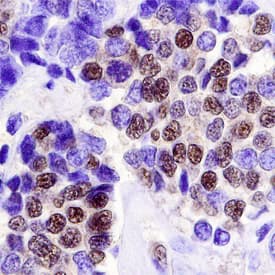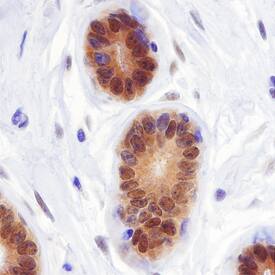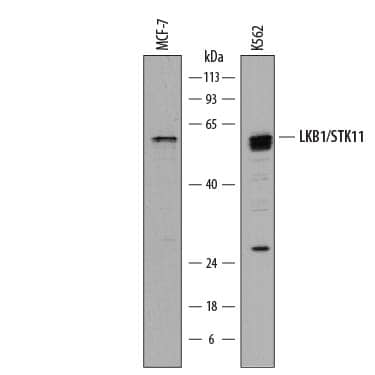Human LKB1/STK11 Antibody
R&D Systems, part of Bio-Techne | Catalog # AF8055

Key Product Details
Validated by
Species Reactivity
Applications
Label
Antibody Source
Product Specifications
Immunogen
Met1-Gln433
Accession # Q15831
Specificity
Clonality
Host
Isotype
Scientific Data Images for Human LKB1/STK11 Antibody
Detection of Human LKB1/STK11 by Western Blot.
Western blot shows lysates of MCF-7 human breast cancer cell line and K562 human chronic myelogenous leukemia cell line. PVDF membrane was probed with 2 µg/mL of Sheep Anti-Human LKB1/STK11 Antigen Affinity-purified Polyclonal Antibody (Catalog # AF8055) followed by HRP-conjugated Anti-Sheep IgG Secondary Antibody (Catalog # HAF016). A specific band was detected for LKB1/STK11 at approximately 55 kDa (as indicated). This experiment was conducted under reducing conditions and using Immunoblot Buffer Group 1.LKB1/STK11 in Human Breast Cancer Tissue.
LKB1/STK11 was detected in formalin fixed paraffin-embedded sections of human breast cancer tissue using Sheep Anti-Human LKB1/STK11 Antigen Affinity-purified Polyclonal Antibody (Catalog # AF8055) at 1 µg/mL overnight at 4 °C. Before incubation with the primary antibody, tissue was subjected to heat-induced epitope retrieval using Antigen Retrieval Reagent-Basic (Catalog # CTS013). Tissue was stained using the Anti-Sheep HRP-DAB Cell & Tissue Staining Kit (brown; Catalog # CTS019) and counterstained with hematoxylin (blue). Specific staining was localized to tumor cell nuclei. View our protocol for Chromogenic IHC Staining of Paraffin-embedded Tissue Sections.LKB1/STK11 in Human Breast.
LKB1/STK11 was detected in formalin fixed paraffin-embedded sections of human breast tissue using Sheep Anti-Human LKB1/STK11 Antigen Affinity-purified Polyclonal Antibody (Catalog # AF8055) at 10 µg/mL overnight at 4 °C. Before incubation with the primary antibody, tissue was subjected to heat-induced epitope retrieval using Antigen Retrieval Reagent-Basic (Catalog # CTS013). Tissue was stained using the Anti-Sheep HRP-DAB Cell & Tissue Staining Kit (brown; Catalog # CTS019) and counterstained with hematoxylin (blue). Specific staining was localized to the cytoplasm and nuclei. View our protocol for Chromogenic IHC Staining of Paraffin-embedded Tissue Sections.Applications for Human LKB1/STK11 Antibody
Immunohistochemistry
Sample: Immersion fixed paraffin-embedded sections of human normal breast and breast cancer tissue subjected to heat-induced epitope retrieval using Antigen Retrieval Reagent-Basic (Catalog # CTS013)
Knockout Validated
Western Blot
Sample: MCF‑7 human breast cancer cell line and K562 human chronic myelogenous leukemia cell line
Formulation, Preparation, and Storage
Purification
Reconstitution
Formulation
Shipping
Stability & Storage
- 12 months from date of receipt, -20 to -70 °C as supplied.
- 1 month, 2 to 8 °C under sterile conditions after reconstitution.
- 6 months, -20 to -70 °C under sterile conditions after reconstitution.
Background: LKB1/STK11
LKB1 (Liver kinase B1; also STK11/Ser/Thr-protein kinase 11 and NY-REN19) is a 55 kDa intracellular member of the LKB1 subfamily, CAMK Ser/Thr protein kinase family of molecules. It is widely expressed, being particularly investigated in small intestinal columnar epithelium and hepatocytes. STK11 is associated with a wide variety of functions, including the initiation of apoptosis through binding to p53, the regulation of TGF-beta signaling through the creation of a SMAD4-LIP1-STK11 complex, and the generation of an epithelial polarized phenotype via cytoskeletal remodeling. Schematically, it would appear that STK11 acts, at least in part, through its ability to phosphorylate multiple AMPK-related kinases, as well as AMPK itself. Human STK11 is 433 amino acids (aa) in length. It potentially contains a three aa propeptide at its C-terminus. The mature segment (aa 1-430) possesses one large protein kinase domain (aa 49-309) plus at least four utilized phosphorylation sites. Phosphorylation on Ser428 promotes the ability of LKB1 to suppress G361 cell growth. Palmitoylation is suggested to occur on Cys418. There are three alternative splice variants. Either individually or in combination, they involve an insertion of nine aa after Tyr126 and a 34 aa substitution for aa 371-433. Full-length human STK11 shares 90% aa sequence identity with mouse STK11.
Long Name
Alternate Names
Gene Symbol
UniProt
Additional LKB1/STK11 Products
Product Documents for Human LKB1/STK11 Antibody
Product Specific Notices for Human LKB1/STK11 Antibody
For research use only



